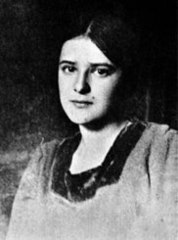
Stanisława Przybyszewska was a Polish writer and dramatist who was born in Kraków in 1901, and was most widely known for her burning interest in the French Revolution. This was immortalised in her trilogy of revolutionary plays: Dziewięćdziesiąty Trzeci (Ninety-third), Sprawa Dantona (The Danton Case), and Thermidor, which were often published together after her death in one volume, Dramaty (e.g. 758:53.d.95.725).
The UL also has a copy of her second and third revolutionary plays in English (758:53.c.95.362). The Danton Case depicts the battle for power between two exceptional individuals: the corrupt sentimental idealist, Danton, and the incorruptible genius of the Revolution, Robespierre. Thermidor shows the final playing out of this drama, as Robespierre, left alone with the heroic absolutist Saint-Just, foresees the ruin of himself and his cause, and in his despair predicts that hatred, war, and capitalism will steal the Revolution and corrupt 19th century man. Although her revolutionary plays are a masterpiece of historical recording, it is Przybyszewska’s own story and her engagement with the life of Robespierre to the exclusion of all else, which I find most fascinating.

Her interest in the Revolution is thought to have begun when she read Georg Büchner’s play Dantons Tod (UL, 9746.d.1731, MML, CDR.G.32), which she poured over eleven times, before immersing herself in multiple rewrites of her own Revolutionary play. Her subject was not Danton, however, but rather his rival, Robespierre, a figure for whom she developed an unquenchable obsession, helped along by her literary and social isolation. By 1928 she had moved into a small set of rooms in Gdańsk attached to the Gimnazjum Polskim (the school her, now dead, husband had worked at) and over the next seven years, she rarely left her self-imposed cell, only initially venturing out to buy a newspaper, or to source her increasingly unstable supply of morphine, upon which she had grown dependent. Throughout the freezing Polish winters, the only thing Przybyszewska had to keep her warm was her burning adoration for her subject.

The UL has a collection of her selected letters translated into English (758:55.c.95.501) often written to other famous writers and contemporaries, but rarely actually posted. In December 1928, she wrote to Janina Przubylska-Skotarek “It’s difficult for me to write, my fingers are weak and numb from the cold. I can’t hit the keys hard enough, and frequently miss them altogether” (page 121), and later in February 1929, “Yesterday it was minus 20 centigrade, today it is minus 25. From top to bottom the windows are overgrown with a thick white fur; it’s better than curtains, but it gives the interior of my room the exact feeling of the most private dwelling, the grave.” (page 131). Her devotion to her craft creates an ironic contrast between her belief in her own genius, and the frankly untenable nature of her final product. The Danton Case was rejected by multiple publishers because it was five or six times the length of most normal plays, reading rather like a vast, never-ending transcript of the Revolution. However, astonishingly, the play was staged in 1931, after three years of negotiations, cut down from an estimated fourteen hours running time. Przybyszewska did not attend the opening, disgusted at the cuts, and she also boycotted the 1933 production, which had turned her script into a vehicle preaching moral obedience towards the right-wing, and discouraging revolution or protests. The most noted legacy of her work is the film Danton (MML Film Collection VID.F.381) with Gérard Depardieu in the title role, but again, the film’s insistence on Robespierre’s role as antagonist wildly differs from Przybyszewska’s focus on his incorruptible integrity.

So why is Stanisława Przybyszewska’s story a fascinating one? To me, her devotion to her talent is both admirable and terrifying. Her last letter, addressed to Thomas Mann, reads “Every object in my room is laden with pain. And nowhere any love.” Her incredible mental discipline to give her life over to the work is truly impressive, and her unflinching determination to record verbatim the Revolution’s every step makes her a good servant to history. But, she is also an awful warning against the dangers of immersing yourself too deeply in your obsession. By the end of her life, she had begun to date her letters using the revolutionary calendar. She had left the 20th century, preferring instead to create a one-sided dialogue with men who had died so long ago “there is not even a single vibration left in the air after them” (758:55.c.95.501, page 126). The late Dame Hilary Mantel used Przybyszewska’s plays to inform her own work on the Revolution, A Place of Greater Safety (1999.9.1396), and said in a lecture in 2017, that “multiple causes of death were recorded, but actually, she died of Robespierre”.
In 1792, Condorcet wrote in the Chronique de Paris, no. 317, “One wonders sometimes why there are so many women following Robespierre, at his home, at the podium of the Jacobins, at the Cordeliers, and the Convention.” In 1928, 136 years later, Stanisława Przybyszewska became one of these women, and so connects us not only to the men of the Revolution, but to the women too: the widows, sisters, fiancées who lived far into the 19th century, mourning a lost time and place, and grieving for men who must have seemed like ghostly giants, looming over their lives.
Do take advantage of the current trial of the French Historical Newspaper database RetroNews, which has a section dedicated to the French Revolution.
Eleanor Chapman-Drake

